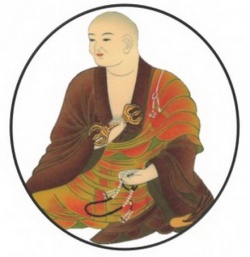Difference between revisions of "Shingon School"
| Line 2: | Line 2: | ||
In the 9th century, the [[Japanese]] [[monk]] [[Kukai]] visited [[China]] and brought back to [[Japan]] the valuable teachings of [[esoteric Buddhism]]. In the [[esoteric]] [[Buddhist tradition]], [[initiations]] and [[rites]] leading to self-awakening and [[enlightenment]] are passed down directly from [[master]] to [[disciple]]. Central to [[esoteric Buddhism]] is the [[belief]] that [[enlightenment]] is not some unreachable goal, but one that can be realised in this [[lifetime]] through patient training under the direct guidance of a [[master]]. | In the 9th century, the [[Japanese]] [[monk]] [[Kukai]] visited [[China]] and brought back to [[Japan]] the valuable teachings of [[esoteric Buddhism]]. In the [[esoteric]] [[Buddhist tradition]], [[initiations]] and [[rites]] leading to self-awakening and [[enlightenment]] are passed down directly from [[master]] to [[disciple]]. Central to [[esoteric Buddhism]] is the [[belief]] that [[enlightenment]] is not some unreachable goal, but one that can be realised in this [[lifetime]] through patient training under the direct guidance of a [[master]]. | ||
| − | One of the oldest schools of [[esoteric Buddhism]] in [[Japan]] is the [[Shingon]] school. [[Shinjo]] | + | One of the oldest schools of [[esoteric Buddhism]] in [[Japan]] is the [[Shingon]] school. [[Shinjo Ito]], the founder of the [[Shinnyo-En order]], received the [[highest]] [[initiation]] of [[Shingon Buddhism]]. [[Shinjo]] Ito underwent [[spiritual]] and [[ascetic]] training as an [[ordained]] [[monk]] at [[Daigo-ji]] [[monastery]], one of the most important training centres of [[Shingon Buddhism]]. He ultimately became a [[great master]] of these teachings – a “[[Dai-Ajari]]” ([[Great Acharya]]) of [[Shingon]]. It was on this [[religious]] base that he founded the [[Shinnyo-En]] order and [[Shinnyo]] [[Buddhism]]. There is still close [[contact]] between [[Shinnyo-En]] and [[Daigo-ji]] – now a {{Wiki|UNESCO}} [[World]] Heritage Site. In 1997, [[Daigo-ji]] [[constructed]] a [[memorial hall]] in honour of [[Shinjo]] Ito and the [[Shinnyo]] [[Buddhism]] which he founded. |
| − | In [[Mahayana Buddhism]], the | + | In [[Mahayana Buddhism]], the [[Great Nirvana Sutra]] is venerated as the [[Buddha’s]] last teachings. The [[sutra]] explains that it is not only those leading a strict [[monastic]] [[life]] that can achieve [[awakening]] and [[enlightenment]]. The [[Buddha]] dedicates his last teachings to a {{Wiki|secular}} [[disciple]] and emphasises the {{Wiki|equal}} value of the efforts of [[monks]] and those who practice as lay followers. |
| − | The Great [[Nirvana Sutra]] is at the [[heart]] of [[Shinnyo | + | The Great [[Nirvana Sutra]] is at the [[heart]] of [[Shinnyo Buddhism]]. [[Shinjo]] Ito combined the [[traditional]] practices of [[esoteric Buddhism]] with the teachings of the Great [[Nirvana Sutra]] to found the [[Shinnyo-En order]], an open [[Buddhist path]] of [[faith]] accessible to all [[people]]. |
{{R}} | {{R}} | ||
[http://www.saisho-goma-berlin.com/en/index.php?option=com_content&view=article&id=7&Itemid=11 www.saisho-goma-berlin.com] | [http://www.saisho-goma-berlin.com/en/index.php?option=com_content&view=article&id=7&Itemid=11 www.saisho-goma-berlin.com] | ||
[[Category:Shingon]] | [[Category:Shingon]] | ||
[[Category:Esoteric Buddhism]] | [[Category:Esoteric Buddhism]] | ||
Latest revision as of 19:50, 14 December 2013
In the 9th century, the Japanese monk Kukai visited China and brought back to Japan the valuable teachings of esoteric Buddhism. In the esoteric Buddhist tradition, initiations and rites leading to self-awakening and enlightenment are passed down directly from master to disciple. Central to esoteric Buddhism is the belief that enlightenment is not some unreachable goal, but one that can be realised in this lifetime through patient training under the direct guidance of a master.
One of the oldest schools of esoteric Buddhism in Japan is the Shingon school. Shinjo Ito, the founder of the Shinnyo-En order, received the highest initiation of Shingon Buddhism. Shinjo Ito underwent spiritual and ascetic training as an ordained monk at Daigo-ji monastery, one of the most important training centres of Shingon Buddhism. He ultimately became a great master of these teachings – a “Dai-Ajari” (Great Acharya) of Shingon. It was on this religious base that he founded the Shinnyo-En order and Shinnyo Buddhism. There is still close contact between Shinnyo-En and Daigo-ji – now a UNESCO World Heritage Site. In 1997, Daigo-ji constructed a memorial hall in honour of Shinjo Ito and the Shinnyo Buddhism which he founded.
In Mahayana Buddhism, the Great Nirvana Sutra is venerated as the Buddha’s last teachings. The sutra explains that it is not only those leading a strict monastic life that can achieve awakening and enlightenment. The Buddha dedicates his last teachings to a secular disciple and emphasises the equal value of the efforts of monks and those who practice as lay followers.
The Great Nirvana Sutra is at the heart of Shinnyo Buddhism. Shinjo Ito combined the traditional practices of esoteric Buddhism with the teachings of the Great Nirvana Sutra to found the Shinnyo-En order, an open Buddhist path of faith accessible to all people.
